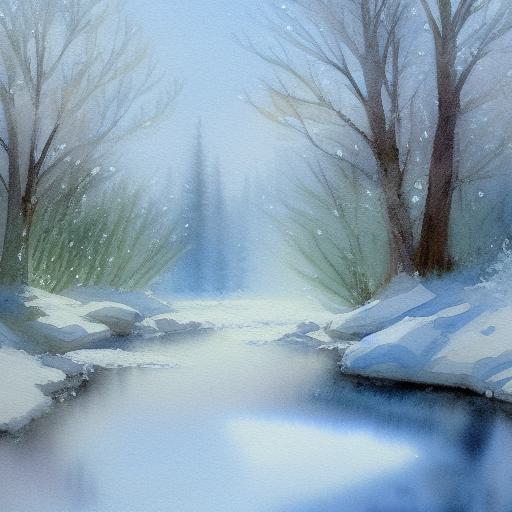How to write this prompt?
Here’s a breakdown of the different elements and how they contribute to generating the desired image:
- “a soft watercolor painting” – This sets the style of the painting as soft and watercolor-like.
- “of snow-covered trees and a stream” – This provides the main subject matter of the image, which is a winter landscape with trees and a stream.
- “with fairies” – This adds a fantastical element to the image, suggesting that there are magical creatures inhabiting this wintry landscape.
- “an watercolor painting by Bob Ross” – This is a reference to a specific artist and style, which can help guide the AI towards producing an image that is similar in style to Bob Ross’s watercolor paintings.
- “flickr” – This may be used to retrieve images from Flickr’s database that match the given keywords, or it may be used to suggest a source of inspiration for the AI.
- “fantasy art” – This suggests that the image should have a fantastical or imaginative quality to it.
- “winter painting” – This sets the tone and mood of the image as being wintry and cold.
- “the light is bright and wintry” – This further reinforces the mood of the image and suggests that the lighting should be bright, but still have a wintry feel to it.
- “soft light of winter” – This describes the quality of the lighting, which should be soft and gentle.
Each of these elements contributes to creating a specific image in the AI’s mind, which it will then try to generate based on the prompt. By carefully selecting and combining these elements, you can guide the AI towards producing an image that matches your desired vision.
What is the significance of using watercolor as a medium in painting?
Watercolor is a popular painting medium due to its unique qualities, such as transparency, luminosity, and fluidity. It allows artists to create soft, dreamy effects and capture the essence of a scene with minimalistic brushstrokes. In the context of the prompt, using watercolor as a style of painting helps to create a soft and gentle winter landscape.
How to create a fantasy atmosphere in a painting?
To create a fantasy atmosphere in a painting, you can use elements such as magical creatures, surreal landscapes, and dreamy lighting. You can also experiment with bold and vibrant colors, exaggerated proportions, and whimsical details. In the context of the prompt, adding fairies to the snow-covered landscape helps to create a sense of magic and fantasy.
Who is Bob Ross and what is his painting style known for?
Bob Ross was an American painter and television host known for his calming demeanor and signature painting style, which involved creating landscapes using a wet-on-wet oil painting technique. His style is characterized by soft, sweeping brushstrokes, muted color palettes, and a focus on nature and wildlife. In the context of the prompt, referencing Bob Ross’s watercolor paintings helps to set a specific style and tone for the AI-generated image.
Are there any copyright issues with using AI-generated art?
There is currently a lot of debate and uncertainty around the issue of copyright for AI-generated art. In most cases, copyright law recognizes the original creator of a work as the owner of the copyright. However, when an AI generates an artwork, it is not clear who the “creator” of the work is, and whether copyright law applies in the same way. Some argue that the person who trained the AI or provided the input data should be considered the creator, while others argue that the AI itself should be considered the creator. Additionally, some argue that AI-generated art may be considered “fair use” or fall under the “public domain” because it was not created by a human. Ultimately, the legal landscape around AI-generated art is still evolving, and it is important to seek legal advice if you are unsure about the copyright implications of using or selling AI-generated art.
Can I sell AI-generated art?
Yes, you can sell AI-generated art, but it is important to consider the copyright implications and potential ethical concerns around the use of AI in art. As mentioned above, it is still unclear who the legal owner of the copyright is for AI-generated art, so it is possible that selling such art could infringe on someone else’s intellectual property rights. Additionally, some may argue that selling AI-generated art is unethical because it does not involve the same level of creativity or personal expression as traditional art forms. However, others may argue that AI-generated art represents a new and innovative form of art that should be celebrated and embraced. Ultimately, the decision to sell AI-generated art is a personal one, but it is important to be aware of the potential legal and ethical implications.
Enhance your designs with stunning AI-generated art using Visual Paradigm Online. With just a few clicks, you can incorporate unique and visually appealing graphics into your projects, thanks to the platform’s user-friendly interface and a wide selection of design templates and assets. Experiment with various styles and layouts until you achieve the perfect combination for your needs. Try Visual Paradigm Online today and take your designs to the next level!


